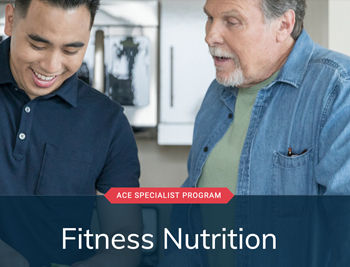
So much of the information our clients consume comes in digital form, with Instagram, Facebook and TikTok among the most popular “information sources” available to consumers. As a qualified health and exercise professional, you likely use these platforms to share educational content and connect with your clients and followers. Unfortunately, unqualified self-proclaimed “gurus” do the same. This is problematic, not only for legitimate professionals but also for consumers searching for answers to their questions about health, fitness and nutrition.
Whether around the dinner table while out with friends or on digital platforms, diets and dieting continue to be popular topics, particularly among women but increasingly among men as well. It’s also a topic rife with information, bias and, for many, shame. In fact, one of the loudest and most pervasive sources of misinformation is “diet culture”—the insidious belief that things like appearance and having an “ideal” body shape is more important than any aspect of well-being. Not surprisingly, the peddlers of diet culture’s dogmatic messaging ultimately do little more than fuel disordered eating and disordered thinking.
Rejecting diet culture requires us to reject the idea that controlling every aspect of one’s diet or body, particularly by limiting what or how much one eats, is normal. This article examines the steps you can take to help your clients identify diet culture and avoid falling into the trap of prioritizing often unattainable ideals at the cost of one’s health and well-being.
What is Diet Culture?
Diet culture is commonly defined as a set of beliefs or practices that worship ultra-thin or muscle-bound body types and equates body size and physical appearance with health or morality. Diet culture is the (inconsistent) lens through which beauty is commonly viewed. A quick perusal of history and art demonstrates just how inconsistent these socially prescribed standards have been.
Five hundred years ago, having a greater amount of body fat was regarded as a source of power, strength, wealth and, oddly enough, health. That same body type today is imbued with shame, judgment and a perception of poor health—a process known as pathologizing. The fashion and entertainment industries continuously shift their definition of “ideal,” with the pendulum swinging from curvy and voluptuous (think Marilyn Monroe) to tall, thin and voluptuous (like Giselle Bündchen), and back again (Jennifer Lopez).
Men aren’t immune to the whims of fashion, either. While muscular physiques were admired in Ancient Greece, men were expected to be thin and smaller-framed (with a preference for intellect over physical strength) during the Gilded Age of the late 19th and early 20th centuries. Today, it’s all about the muscles again, with a “ripped,” fat-free physique serving as the ideal.
While there’s no predicting what might be the next “ideal,” it is safe to say that it will change again at some point. And they will continue to be influenced by culture, fads, fashion trends and, of course, social media, where diet culture lives and thrives.
The Dangers of Diet Culture
According to the National Eating Disorders Association (NEDA), “diet culture is dangerous and harms people of all sizes…by perpetuating eating disorders and making a full recovery almost impossible.” Ragen Chastain, a NEDA Ambassador and ACE Certified Health Coach, shares the following six consequences associated with diet culture and its dangerous mentality:
Diet culture…
- Conflates size and health, pathologizing some body sizes.
- Encourages following external rules about what, when and how much to eat.
- Suggests that people are more or less good/moral/worthy based on their body size.
- Creates thin privilege, which makes thinness a gatekeeper for things like jobs, benefits, comfort and accommodation.
- Suggests movement as punishment for, or prevention of, being larger, rather than for other reasons like fun or personal goals.
- Views people in larger bodies as less valuable and emphasizes that the goal of being thin is worth the risk of losing their lives.
To further illustrate the consequences of diet culture mentality, the National Association of Anorexia Nervosa and Associated Disorders (ANAD) highlights these alarming statistics:
- Eating disorders affect at least 9% of the population worldwide.
- Nine percent of the United States population, or 28.8 million Americans, will have an eating disorder in their lifetime.
- Less than 6% of people with eating disorders are medically diagnosed as “underweight.”
- Eating disorders are among the deadliest mental illnesses, second only to opioid overdose.
- An estimated 10,200 deaths each year are the direct result of an eating disorder—that’s one death every 52 minutes.
- About 26% of people with eating disorders attempt suicide.
- The economic cost of eating disorders is $64.7 billion every year.
Bringing this closer to home for those who are parents or play a role in influencing young lives and minds, consider that 42% of girls in grades first through third want to be thinner or change something about their bodies (NEDA). By the age of 10, 81% of girls have a fear of being “fat,” and more than half of middle school–aged girls and boys are engaging in unhealthy weight-control behaviors.
Clearly, the consequences of diet culture messaging and mantras is far reaching and negatively impactful on multiple levels. In addition to these alarming statistics, research also suggests that exposure to content related to diet culture, social media diet culture images and messaging, and #fitspiration messaging can result in increased body dissatisfaction. Often, female celebrities or fitness models drive the messaging. As a result, this type of content and #fitspiration messaging is perceived by consumers (and by professionals) as setting the “ideal” representation of health and fitness.
In my 20-year career, I have had multiple students, clients and colleagues tell me that they’ve seen an image on the cover of an air-brushed magazine or on social media and thought, “If I do the same things this person is doing, I could look like them.” There’s a falsely perceived connection between thinness (or exceptionally muscular physiques) and health. Intellectually and educationally, we understand that this is not the case. But like words, images have power and they aren’t always used for good.
Combatting Common Diet Culture Messages
As health and exercise professionals, it is not within our role or scope—or even worth our energy—to try to eradicate diet culture and the misinformed or uneducated “professionals” that disseminate it. Attempting to do so is a losing battle and not where our time or efforts are best spent.
Our work with clients involves more than providing a workout program, leading a fitness class or coaching behavior change. We are uniquely positioned to use evidence-based information to our advantage. If we invest time educating our clients and supporting those efforts with evidence, we can begin to mute the din of influencers, “gurus” and #fitspiration posts.
Here are some common diet culture messages, along with guidance on how to use evidence to refute the falsehoods clients encounter.

“For best results, avoid bread and other carbohydrate-based foods.”
Strategies to employ:
- Ask your client what fears they have about carbohydrate-based foods. Explore the root source and cause of these concerns.
- Teach clients about the role carbohydrates play in the body and how they can fuel performance.
- Help clients read food labels and to identify highly processed ingredients.
- Have a conversation about energy versus nutrients and the important role each of these play in good health.

“I understand that if I’m trying to lose weight, cauliflower can be a great substitute for potatoes and starches.”
Strategies to employ:
- Validate that cauliflower provides supportive nutrients.
- Encourage clients to try recipes and offer to share any you have tried.
- Revisit the role carbohydrates play in the body and in performance gains.
- Consider having a conversation about the health-halo effect, which means that not every product that is made with cauliflower (or other “healthful” ingredient) is a reasonable (or healthy option).
- If clients try a recipe and don’t enjoy it, reinforce that it is O.K. and may be more beneficial to use the original recipe and include a whole-grain source.

“I am cutting out sugar because it is awful for me.”
Strategies to employ:
- Help clients identify sources of sneaky sugars in items such as condiments, sauces and even peanut butter. (See Figure 1 for a cheat sheet with all the various names of sugar that you can share with your clients.)
- Reinforce that sugar can be a part of a healthy, balanced diet.
- Share recipes with natural sugar options (pureed fruit, for example) if sugar is a concern.


“I saw a video about how always eating clean can lead to weight loss.”
Strategies to employ:
- Explore what “clean eating” means to the client. Most of the time, this means they want to identify healthier food options (such as switching out white bread for whole grains, for example).
- Help clients define, for themselves, what healthy means to them.
- Introduce language that doesn’t categorize food as good or bad or clean or dirty. This might mean learning to describe foods using words or phrases such as savory, rich, sweet, decadent, fresh, colorful, bright or packed with vitamins.
- Help clients focus on what they can add to their nutrition versus what they need to restrict.

"I want to make healthy progress by losing weight."
When examined in isolation, weight loss really isn’t an accurate measurement of health. For example, unintentional weight loss might mean there’s an issue (disease-state, nutrient deficiency, disordered eating or a mental health concern). To better assess health, we need to examine a wide range of factors, such as blood pressure, sleep, stress levels, body composition and mental health. A change in weight is one measurement and it isn’t even the most revealing.
Strategies to employ:
- Guide clients in process goal setting (versus product goal setting).
- Ask clients to define progress and have a conversation about what non-scale progress includes (for example, better sleep, happier mindset or increased energy levels).
This list of diet culture messages is by no means exhaustive. Other common messages include earning calories, good versus bad foods, before and after photos, the idea that a person’s problems can be connected to their body size, gaining weight is “bad” and losing weight is “good,” and happiness and life satisfaction is directly affected by a person’s size or weight. Having a conversation about diet culture, its impact and its consequences among ourselves and with our clients is crucial. We need to have the courage to call out what is misaligned in these messages and the flimsy “science” they are founded upon.
Diet culture is about image and restriction. As a legitimate and credentialed professional, you use an evidence-based approach to support behavior change and nurture a sense of balance and harmony for your clients. Instead of restricting, you focus on what you can add to bring a greater balance to a client’s eating patterns, exercise routines or stress management practices and consider all aspects of health and wellness.
Expand Your Knowledge
 |
The ACE Fitness Nutrition Specialist Program is designed for health and exercise professionals who want to gain a deeper understanding of nutrition, learn how to help clients implement healthy food choices into their daily routine and understand how to address special nutritional needs for different types of clients, from those simply looking to get healthier to competitive athletes. You’ll learn how to guide clients in selecting fresh, nutrient-dense foods, and couple this knowledge with behavior change strategies that will help your clients turn smart choices into long-term habits.
|
 |
As an exercise professional or health coach, it is important to remain within the scope of your practice when coaching nutrition and better nutrition choices to your clients. The Applying Nutrition Principles course bundle will equip you with information and meaningful behavior change techniques to help you support your clients in healthier food choices and implement into your practice immediately.
|
 |
Successful coaches realize that understanding nutrition science isn’t enough. You must also be able to effectively help others change their eating and lifestyle behaviors. This comprehensive nutrition course will provide you with a deep understanding of nutrition and the confidence to coach it so you can get sustainable results for your clients—all in one practical system. You’ll also get the tools to start or grow a successful coaching business, whether full-time or part-time, in-person or online.
|





 by
by 






